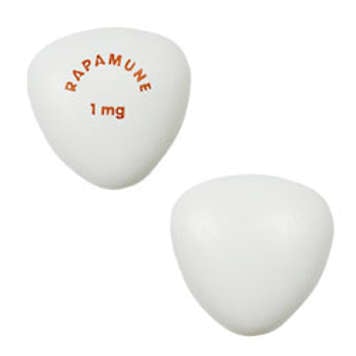Also known as rapamycin or Rapamune®

What is sirolimus?
Sirolimus works by preventing your body from rejecting your new organ. It is called an immunosuppressant or an anti-rejection medication.
What sirolimus looks like
Sirolimus can come in a tablet or a liquid. Here is a photo of one brand of sirolimus, called Rapamune®.
Note: This photo is a close-up of the medication; it is not to scale.
How to take sirolimus
- Wash your hands before and after handling sirolimus.
- Take sirolimus every day at the same time.
- You can take sirolimus with food or without food, but take it the same way each time. Food does not have a big effect on how much sirolimus passes from your stomach into your blood.
- Take sirolimus with the same type of drink each day, but avoid grapefruit juice, even if it is mixed in with other fruit juices. Grapefruit raises the sirolimus levels in your blood, which can lead to more side effects. Also, never eat pomelos, tangelos or any other fruit that is a hybrid (mix) of grapefruit and another fruit. Always read food labels carefully to ensure there is no grapefruit in a product.
Taking sirolimus tablets
- Swallow sirolimus tablets whole.
- Do not cut or crush the tablets. Doing so will damage their special coating.
Taking sirolimus suspension (liquid)
- Shake the bottle well before measuring each dose.
- Use the special brown syringe provided with the medicine to measure the dose. Mix the sirolimus in a glass with 40-60 mL of water or orange juice. Keep stirring the mixture for one minute and then drink it. (Do not try sirolimus with other liquids without first asking the transplant team.) Stirring in the sirolimus is really important, as it prevents it from causing mouth sores.
- Pour another 40 mL of water or orange juice into the glass, to rinse any remaining sirolimus, and drink it.
- If you are taking sirolimus through a feeding tube, mix it with 20 mL water (otherwise it will be very thick!) and then flush the tube with 10-20 mL of water after you take your dose. This should stop the sirolimus from clogging the tube.
- Wash away any liquid on your hands right after you take your dose.
Possible side effects of sirolimus
- Nausea (upset stomach), vomiting (throwing up)
- Diarrhea (watery stools)
- Mild headache
- High cholesterol and/or triglyceride levels
- Greater risk of infections – sirolimus lowers your white blood cell count (white blood cells help fight infection)
- Tiredness or fatigue – sirolimus can lower your red blood cell (hemoglobin) count (hemoglobin provides energy to the body)
- Heavier or longer bleeding from any cuts – sirolimus can lower your platelet count (platelets help stop bleeding)
- High blood pressure
- Delayed wound healing
- Acne
- Stress on the liver, shown by an increase in liver function (transaminases) tests when blood work is done
- Leg cramps
- Lung inflammation (swelling)
How to store sirolimus
- Keep sirolimus out of reach of any small children.
Sirolimus tablets
- Keep them at room temperature in a cool dry place away from sunlight.
- Never store them in the bathroom or near heat sources in the kitchen.
- Never store them in the refrigerator or freezer.
Sirolimus suspension (liquid)
- Keep sirolimus liquid in the refrigerator. Never store it in the freezer.
- Sirolimus liquid is stable for 30 days from when you open the bottle. Write the date that you opened the bottle on the label.






